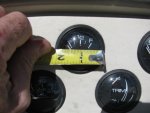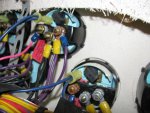SMullenMaine
Cadet
- Joined
- Sep 6, 2012
- Messages
- 25
Hi all,
My fuel gauge reads E all of the time... previous owner told me that the tank sender has been tested and working.
so...
Should I believe him? is there an easy way to check? I have Ohmmeter, but don't know what to look for...
Can I buy a gauge like Iboats part# 13001 and simply replace it?
How do I get the old one out? is it the terminal nuts that hold it into the black plastic frame?
Will the new one have the same terminal config and fit in the same spot?
attached pics show front of gauge and up in behind the dash (top left of photo)
Thanks,
Steve Mullen, Portland, Maine
My fuel gauge reads E all of the time... previous owner told me that the tank sender has been tested and working.
so...
Should I believe him? is there an easy way to check? I have Ohmmeter, but don't know what to look for...
Can I buy a gauge like Iboats part# 13001 and simply replace it?
How do I get the old one out? is it the terminal nuts that hold it into the black plastic frame?
Will the new one have the same terminal config and fit in the same spot?
attached pics show front of gauge and up in behind the dash (top left of photo)
Thanks,
Steve Mullen, Portland, Maine





















